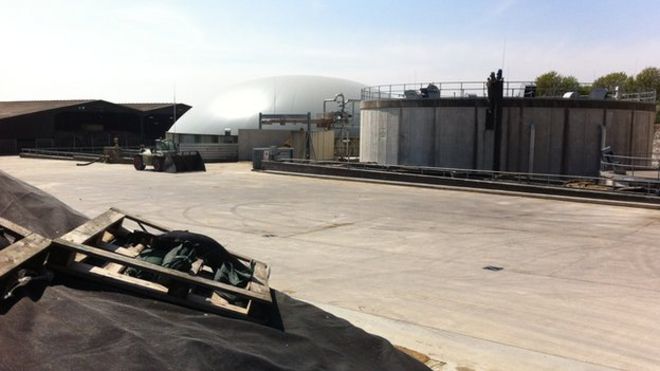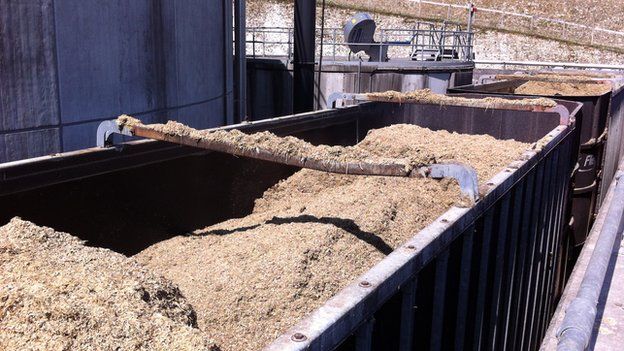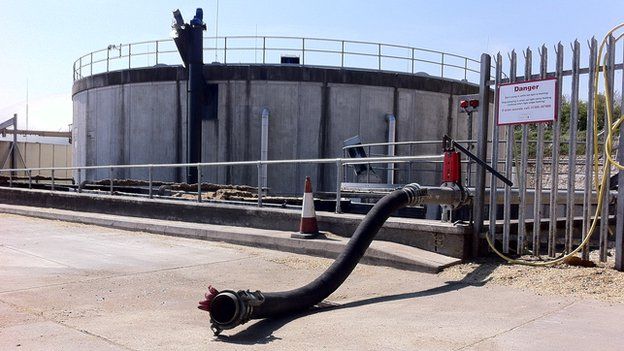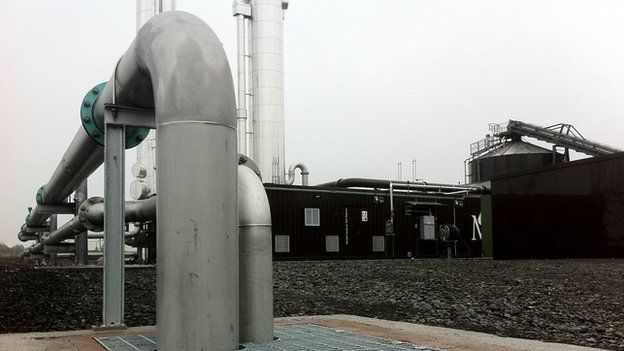The rise of green gas: Turning crops into energy
- 11 May 2015
- Business

Solar panels and wind turbines got us used to the idea of green electricity, but what's called "green gas" is less well-known.
However, the UK is experiencing a modest boom in its production, with the number of sites pumping it into the national grid rising more than nine-fold in the space of a year.
Just outside Dorchester in Dorset in south west England, a huge white dome rises out of the ground on land. In the barn opposite, cows are grazing, their heads bobbing in and out of feeding troughs.
This is part farm, part industrial estate, with the focus less on livestock, and more on generating energy.
The dome is part of an anaerobic digestion plant which makes some electricity, but mostly gas pumped straight into the pipelines which feed our homes and businesses.
When it started production in 2012, it was the first commercial facility of its kind in the country. Now it is one of dozens.
Energy to the grid
It feeds on leftover food collected from pubs and restaurants in London, and delivered by tanker down to Dorset. But that is not all.
"We are taking energy crops that we grow on land around the plant," the farmer and business director, Nick Finding, told the BBC.
In front of us, piles of maize and rye chopped up like sawdust can be seen in two large hoppers. Potato waste is also used from a plant in nearby Weymouth.

"What we are doing is putting it into a fermenting process to create biogas which generates electricity to run the plant," says Mr Finding, adding that the surplus is used to supply around 500 homes with power.
"We're getting the methane cleaned out of the biogas to be injected as biomethane into the grid."
The process is a bit like composting only without oxygen. Bacteria produce the methane as they digest or break down the crops and food slurry.
That means, unlike natural gas, this is not a fossil fuel.
"It does release carbon dioxide into the atmosphere but we're just forming part of a cycle," says Ciaran Burns from the Renewable Energy Association.
"The plants that are used to make food waste and such when they grow they absorb carbon dioxide from the atmosphere.
"Then when we use them to create and burn biomethane we are just releasing the CO2 that was captured when those plants were growing. We're not actually contributing any extra CO2 to the atmosphere."
'Breaking even'
The site in Dorset is operated by JV Energen - a joint venture between the Duchy of Cornwall and three farmers.
It was set up to provide renewable energy to Poundbury, an urban extension of Dorchester built on land belonging to the Duchy of Cornwall.
It means Prince Charles has taken a keen interest in the project, performing its official opening in November 2012.

The plant makes money from government subsidies for renewable energy, and by selling the gas and electricity it generates. By now it was expected to be in profit but it's not.
"It's just about breaking even. I think it's very successful," says Nick, pointing out how many other developers have followed their lead.
Environmental worries
In 2013 there were just two other plants in the UK injecting biomethane into the gas grid. By 2014 that figure had risen to 28 according to the Renewable Energy Association (REA), and 50 are expected to be operational by the end of this year.
"Germany is leading the way," says the REA's Ciaran Burns. "Netherlands and Austria are relatively well established, but the UK is the fastest growing market for the development of biomethane plants."
The environmental campaign group, Friends of the Earth, says green gas can be a "genuinely sustainable and low carbon source of energy when it is captured from landfill sites or produced from agricultural wastes".
But it is worried about other means of production.
"Over half of the feedstock used for biogas production in Europe in 2012 came from agricultural crops; in particular maize," it says.
"This practice competes with food production and has already led to large scale land-use change in countries like Germany leading to so-called 'maize deserts'.
"Such industrial-scale maize monocultures are bad for wildlife and particularly prone to soil erosion and flooding."
Waste power
In Dorset, the maize comes from land used to grow different things from one year to the next. One of the UK's newest sites in Newcastle upon Tyne uses no crops at all. Instead it relies entirely on what we flush down the loo.
"Northumbrian Water has a catchphrase we have developed around power from pooh," says Richard Warneford, the company's Wastewater Director.
"This is around taking the sewage sludge from all of the sewage treatments works and ultimately generating gas or electricity at the end of the process."

It is not the first water company in the UK to generate energy from human waste, but it does claim to be the biggest.
All of the sludge from its more than 400 sewage treatment works is used to make power - either electricity but now also biomethane going straight into the gas grid.
It has cost over £40m pounds in investment, but Mr Warneford expects the business to make £3m a year.
"This is a waste product that would otherwise have been a problem to get rid of, but for us now we see it as a fuel."
No comments:
Post a Comment